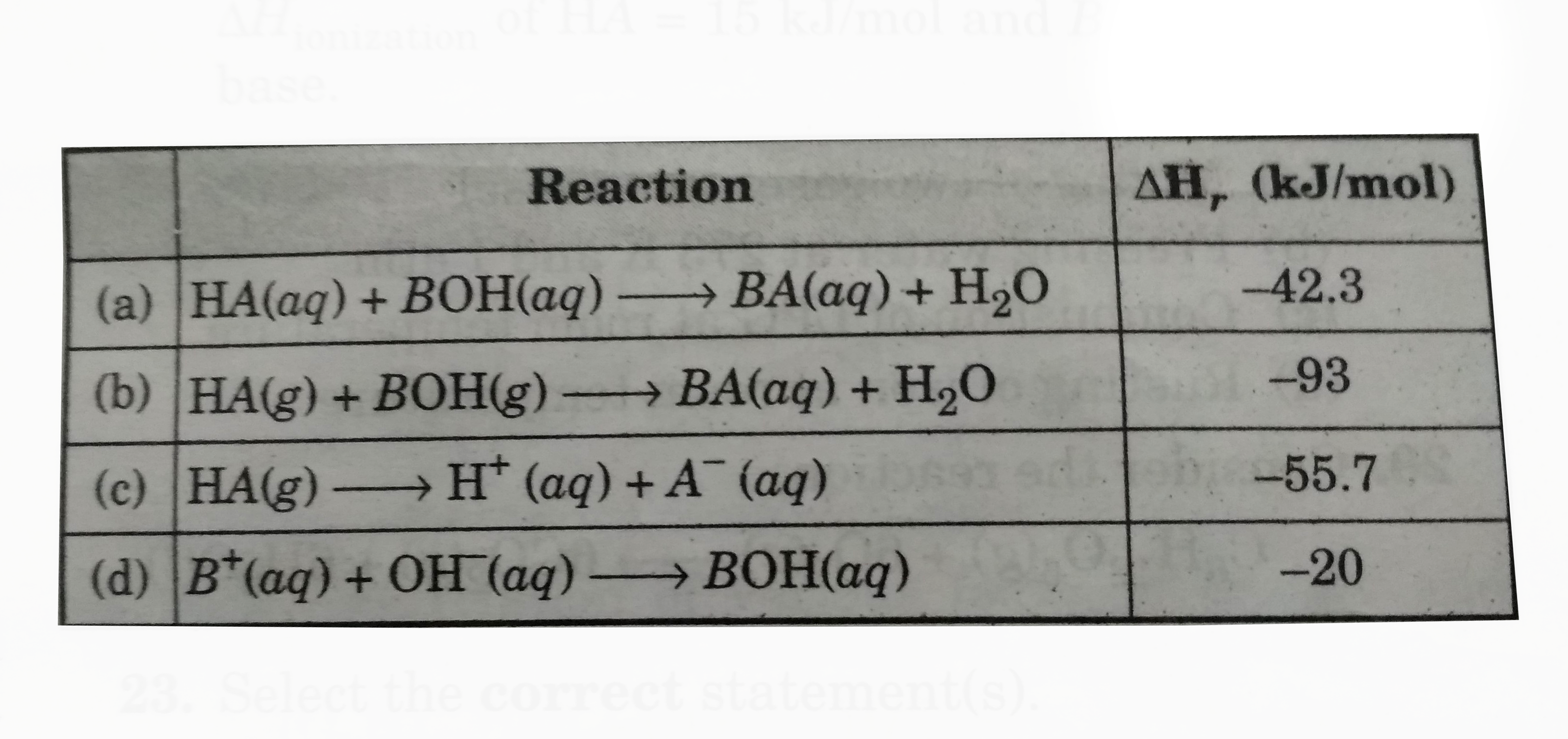What is the enthalpy of neutralization of HF against a strong base?
Given : H+(aq)+OH−(aq)→H2O(l),ΔrH∘=−56kJ/mol
ΔsH∘(HF,aq)=−329kJ/mol,ΔsH∘(H2O,l)=−285kJ/mol
ΔsH∘(F−,aq)=−320 kJ/mol
−17 kJ/mol
−38 kJ/mol
−47 kJ/mol
−43 kJ/mol
The correct Answer is:C
To calculate the enthalpy of neutralization of HF against a strong base, we can use the given enthalpy values and the reaction involved. Here’s a step-by-step solution:
Step 1: Write the Neutralization Reaction
The neutralization of hydrofluoric acid (HF) with a strong base (like NaOH) can be represented as:
HF (aq)+OH−(aq)→F−(aq)+H2O(l)
Step 2: Identify the Enthalpy Change
The enthalpy change for the neutralization reaction can be expressed as:
ΔHneutralization=ΔHproducts−ΔHreactants
Step 3: Write the Enthalpy of Products
The products of the reaction are F⁻ (aq) and H₂O (l). The enthalpy values provided are:
- ΔH0f(F−)=−320kJ/mol
- ΔH0f(H2O)=−285kJ/mol
Thus, the total enthalpy of the products is:
ΔHproducts=ΔH0f(F−)+ΔH0f(H2O)=−320+(−285)=−605kJ/mol
Step 4: Write the Enthalpy of Reactants
The reactants are HF and OH⁻. The enthalpy values provided are:
- ΔH0f(HF)=−329kJ/mol
- The enthalpy of OH⁻ can be derived from the known reaction:
H+(aq)+OH−(aq)→H2O(l)
Given ΔH0r=−56kJ/mol, we can find the enthalpy of OH⁻:
−56=0+ΔH0f(OH−)−285
ΔH0f(OH−)=−56+285=−229kJ/mol
Thus, the total enthalpy of the reactants is:
ΔHreactants=ΔH0f(HF)+ΔH0f(OH−)=−329+(−229)=−558kJ/mol
Step 5: Calculate the Enthalpy of Neutralization
Now we can substitute the values into the equation for the enthalpy of neutralization:
ΔHneutralization=ΔHproducts−ΔHreactants
ΔHneutralization=−605−(−558)=−605+558=−47kJ/mol
Final Answer
The enthalpy of neutralization of HF against a strong base is:
ΔHneutralization=−47kJ/mol
---
The neutralization of hydrofluoric acid (HF) with a strong base (like NaOH) can be represented as:
HF (aq)+OH−(aq)→F−(aq)+H2O(l)
The enthalpy change for the neutralization reaction can be expressed as:
ΔHneutralization=ΔHproducts−ΔHreactants
The products of the reaction are F⁻ (aq) and H₂O (l). The enthalpy values provided are:
- ΔH0f(F−)=−320kJ/mol
- ΔH0f(H2O)=−285kJ/mol
ΔHproducts=ΔH0f(F−)+ΔH0f(H2O)=−320+(−285)=−605kJ/mol
The reactants are HF and OH⁻. The enthalpy values provided are:
- ΔH0f(HF)=−329kJ/mol
- The enthalpy of OH⁻ can be derived from the known reaction:
H+(aq)+OH−(aq)→H2O(l)
Given ΔH0r=−56kJ/mol, we can find the enthalpy of OH⁻:
−56=0+ΔH0f(OH−)−285
ΔH0f(OH−)=−56+285=−229kJ/mol
ΔHreactants=ΔH0f(HF)+ΔH0f(OH−)=−329+(−229)=−558kJ/mol
Now we can substitute the values into the equation for the enthalpy of neutralization:
ΔHneutralization=ΔHproducts−ΔHreactants
ΔHneutralization=−605−(−558)=−605+558=−47kJ/mol
The enthalpy of neutralization of HF against a strong base is:
ΔHneutralization=−47kJ/mol
Topper's Solved these Questions
- THERMODYNAMICSBook:NARENDRA AWASTHI ENGLISHChapter:THERMODYNAMICSExercise:Level 3
Explore 89 Videos
- THERMODYNAMICSBook:NARENDRA AWASTHI ENGLISHChapter:THERMODYNAMICSExercise:Level 3
Explore 89 Videos
- STOICHIOMETRYBook:NARENDRA AWASTHI ENGLISHChapter:STOICHIOMETRYExercise:Match the Colum-II
Explore 6 Videos
Similar Questions
The fat, C57H104O6(s), is metabolized via the following reaction. Given the enthalpies of formation, calculate the energy (kJ) liberated when 1.0 g of this fat reacts.
C57H104O6(s)+80O2(g)→57CO2(g)+52H2O(l)
ΔfH∘(C57H104O6,s)=−70870 kJ/mol, ΔfH∘(H2O,l)=−285.8 kJ/mol,
ΔfH∘(CO2,g)=−393.5 kJ/mol
View SolutionDetermine the enthalpy of formation of B2H6(g) in kJ/mol of the following reaction :
B2H6(g)+3O2(g)→B2O3(s)+3H2O(g),
Given : ΔrH∘=−1941 kJ/mol, ΔH∘f(B2O3,s)=−1273 kJ/mol,
ΔH∘f(H2O,g)=−241.8 kJ/mol
View Solution
Knowledge Check
What will be the heat of reaction for the following reaction? Will the reaction be exothermic or endothermic?
Fe2O3(s)+3H2(g)→2Fe(s)+3H2O(l)
ΔfH∘(H2O,l)=−285.83 kJ mol−1
ΔfH∘(Fe2O3,s)=−824.2 kJ mol−1A−824. 2 kJ mol−1, exothermicB+33.3 kJ mol−1, endothermicC−33.3 kJ mol−1, exothermicD+824.2 kJ mol−1, endothermic
Determine C-C and C-H bond enthalpy (in kJ/mol)
Given : ΔfH∘(C2H6,g)=−85kJ/mol, ΔfH∘(C3H8,g)=−104kJ/mol
ΔsubH∘(C,s)=718kJ/mol, B.E.(H−H)=436kJ/mol
View SolutionDetermine enthalpy of formation for H2O2(l), using the listed enthalpies of reaction :
N2H4(l)+2H2O2(l)→N2(g)+4H2O(l),
ΔrH∘1=−818kJ/mol
N2H4(l)+O2(g)→N2(g)+2H2O(l)
ΔrH∘2=−622kJ/mol
H2(g)+12O2(g)→H2O(l) ΔrH∘3=−285kJ/mol
View SolutionFrom the following date , mark the opation(s) where ΔH is correctly written for the given reaction .
Given: H+(aq)+OH−(aq)→H2O(l),
ΔH=−57.3kJ
ΔHsolutionHA(g)=−70.7kJmole
ΔHsolutionBOH(g)=−20kJmole
ΔHionzatoin of HA=15kJ/mole and BOH is a strong base.

View SolutionThe bond dissociation energy depends upon the nature of the bond and nature of the molecule. If any molecule more than 1 bonds of similar nature are present then the bond energy reported is the average bond energy.
Determine C−CandC−H bond enthalpy (in kJ/mol). Given: ΔfH0(C2H6,g)=−85kJ/mol,ΔfH0(C3H8,g)=−104kJ/mo≤,ΔsubH0(C,s)=718kJ/mol, B.E. (H-H)= 436 kJ/mol,
View SolutionCalculate standard free energy change from the free energy of formation data for the following reaction, C6H6(l)+152O2(g)→6CO2(g)+3H2O(g).
ΔfGθ[C6H6(l)]=172.8 kJ/mol
ΔfGθ[CO2(g)]=−394.4 kJ/mol
ΔrGθ[H2O(l)]=−228.6 kJ/mol
View SolutionCalculate ΔrGc− of the reaction :
Ag⊕(aq)+Clc−(aq)→AgCl(s)
Given :ΔfGc−.AgCl=−109kJmol−1
ΔfGc−_((Clc−))=−129kJmol−1
ΔfGc−.(Ag⊕)=−77kJmol−1
View SolutionThe enthalpy of reaction for the reaction
2H2(g)+O2(g)→2H2O(l) is ΔrHΘ=−572kJmol−1
What will be standard enthalpy of formation of H2O(l) ?
View Solution